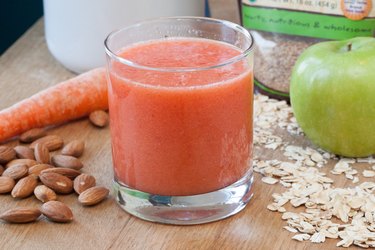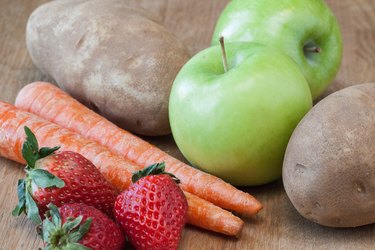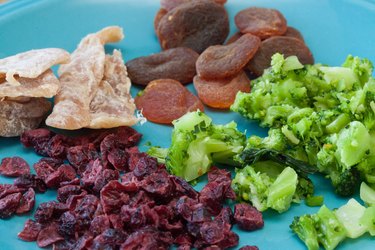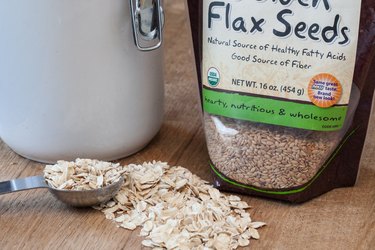
A protein shake can be a convenient and healthy breakfast or lunch, and with more fiber, the shake helps you stay full longer. You can choose from sources of soluble fiber, such as dried beans and peas, and insoluble fiber, such as bran. Insoluble fiber, which does not dissolve in water, and soluble fiber, which does dissolve, both help regulate your digestive system, so try to mix both into your shake, or alternate from day to day.
Double Duty
Video of the Day

Choosing a liquid that is high in both protein and fiber gives you a head start on adding fiber to the shake. Instead of choosing dairy milk, which has no fiber, choose soy milk with fiber added by the manufacturer to get almost as much protein as milk, but with 5 g. of fiber as well. Substitute high-fiber soy milk for the same amount of regular milk, or use a half-and-half blend of soy milk and dairy milk.
Video of the Day
Eat Your Veggies and Fruits

All vegetables contain some insoluble fiber, but some have more than others, such as green beans, kale, potatoes and turnips. Fruits high in this fiber include raw apples and pears, with their skins left on. Try leaving room in the blender for an equal amount of fruits and veggies that contain soluble fiber. To save time in the morning, cook vegetables ahead of time, or simply use any leftover vegetable from last night's dinner.
Fruitful Opportunities

Many fresh and dried fruits, such as nectarines, mangoes, prunes and avocados, are high in soluble fiber. Cooked vegetables with high amounts include asparagus, soybeans, broccoli, collards and eggplant. Tofu also contains lots of soluble fiber. Add 1/2 cup of soluble produce for each 1/2 cup of insoluble produce if you're mixing fiber types.
The Best of Both Worlds

Foods with both soluble and insoluble fiber, such as flax seeds, give your shake a huge fiber boost. Grind flax seeds in a coffee grinder to break them down, allowing your body to better absorb their nutritional benefits as well as their fiber. Other foods with both types of fiber include oat bran, oat flakes, bran cereal, raw carrots, apricots, figs and oranges. About 2 tablespoons of grains or seeds per 1-cup serving of fruit is standard.
- University of Nebraska-Lincoln Extension: Dietary Fiber
- USDA Agricultural Research Service: Basic Report: 16243, SILK Plus Fiber, soymilk
- USDA Agricultural Research Service: Basic Report: Basic Report: 01079, Milk, reduced fat, fluid, 2% milkfat, with added vitamin A and vitamin D
- Harvard University Health Services: Fiber Content of Foods in Common Portions
- Dietitians of Canada: Food Sources of Soluble Fibre
- Flax Council of Canada: Flax FAQ
- Academy of Nutrition and Dietetics: Nutrition for Older Men
- Flax Council of Canada: Flax - A Healthy Food